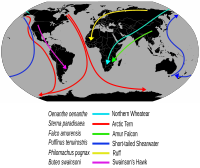
Photo from wikipedia
Abstract Determining the geographic connections between breeding and nonbreeding populations, termed migratory connectivity, is critical to advancing our understanding of the ecology and conservation of migratory species. Assignment models based… Click to show full abstract
Abstract Determining the geographic connections between breeding and nonbreeding populations, termed migratory connectivity, is critical to advancing our understanding of the ecology and conservation of migratory species. Assignment models based on stable isotopes historically have been an important tool for studying migratory connectivity of small‐bodied species, but the low resolution of these assignments has generated interest into combining isotopes with other sources in information. Abundance is one of the most appealing data sources to include in isotope‐based assignments, but there are currently no statistical methods or guidelines for optimizing the contribution of stable isotopes and abundance for inferring migratory connectivity. Using known‐origin stable‐hydrogen isotope samples of six Neotropical migratory bird species, we rigorously assessed the performance of assignment models that differentially weight the contribution of the isotope and abundance data. For two species with adequate sample sizes, we used Pareto optimality to determine the set of models that simultaneously minimized both assignment error rate and assignment area. We then assessed the ability of the top models from these two species to improve assignments of the remaining four species compared to assignments based on isotopes alone. We show that the increased precision of models that include abundance is often offset by a large increase in assignment error. However, models that optimally weigh the abundance data relative to the isotope data can result in higher precision and, in some cases, lower error than models based on isotopes alone. The top models, however, depended on the distribution of relative breeding abundance, with patchier distributions requiring stronger downweighting of abundance, and we present general guidelines for future studies. These results confirm that breeding abundance can be an important source of information for studies investigating broad‐scale movements of migratory birds and potentially other taxa.
Journal Title: Ecology and Evolution
Year Published: 2017
Link to full text (if available)
Share on Social Media: Sign Up to like & get
recommendations!